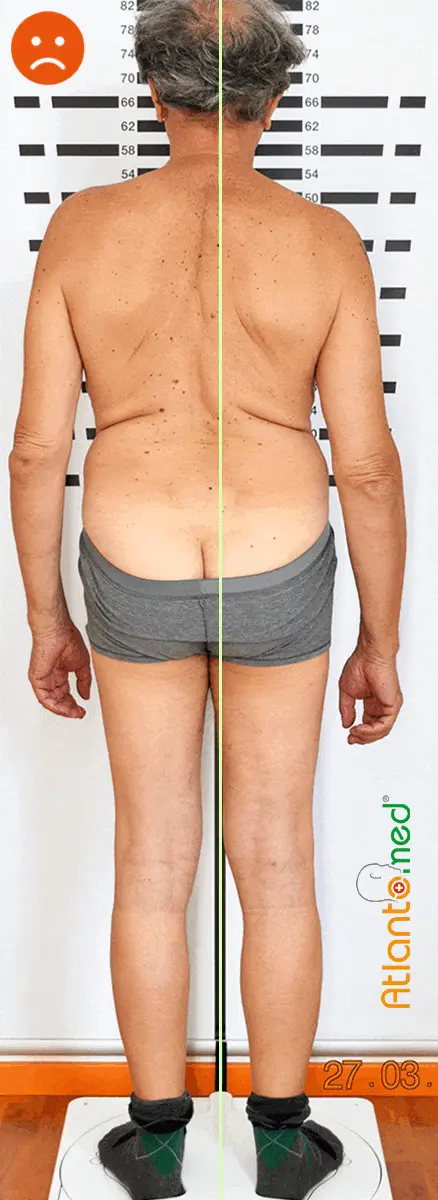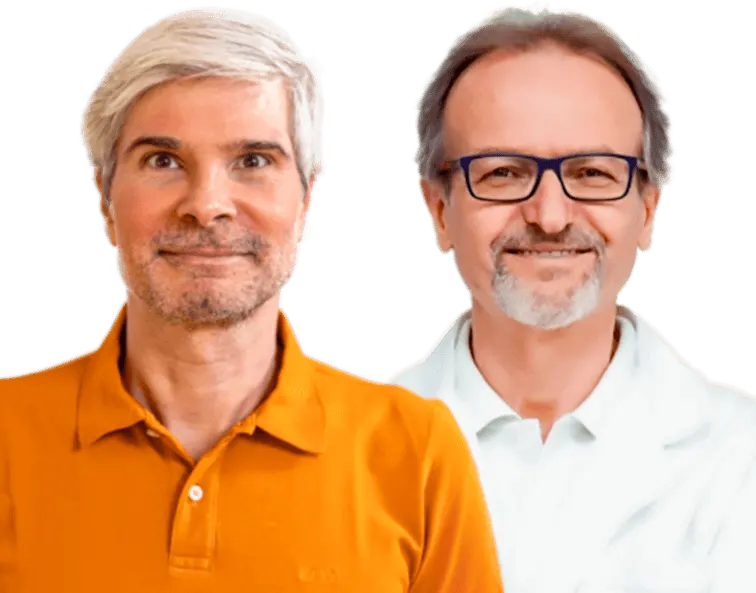Scoliosis and Atlas Vertebra

BEFORE
AFTER
Scoliosis occurs when the spine, instead of maintaining its natural curvature, adopts an abnormal S or C shape, often accompanied by a twist.
People suffering from scoliosis have probably already gathered extensive information about their condition. For this reason, we avoid focusing on unnecessary medical details that the reader likely already knows.
According to conventional medicine, the cause of scoliosis is unknown in 90% of cases, which is why it is labeled "idiopathic scoliosis." This term, in simple words, means that neither the cause nor an effective solution is known.
Scoliosis affects about 5% of the population, usually appears after the age of 10, and is more common in girls than boys.
If you have explored the rest of the site, you will understand that we like to delve deeper to uncover the truth. You might not like learning that, according to data collected by Germany's top health authority, the Robert Koch Institute, and later summarized in a study called KiGGS, it turns out that:
Scoliosis and Vaccination
What could be the mechanism linking vaccinations to scoliosis? Vaccines contain mercury, a metal known for its high neurotoxicity. Once injected into the arm, it could spread asymmetrically throughout the body, selectively affecting certain parts of the nervous system. This could influence muscle control, altering the balance of the musculature responsible for supporting the skeleton, thereby promoting the development of scoliosis. Vaccine-related damage is systematically concealed, which is why we are making this information available.
It is noteworthy that the firstborn child is often the most affected. Nature, in its mechanism of species preservation, tends to prioritize the mother, which is why higher levels of toxic substances can be found in the firstborn fetus. To this, we must add the mercury derived from the entire series of vaccinations the child is later subjected to.
It is crucial that people are informed! Scoliosis is discussed on page 5 of this study, but the other information contained in the document is also essential for the health of your children. If you read and fully understand this data, your choice will become clear. And it is precisely for this reason that such information is made difficult to access and deliberately not disclosed.
Scoliosis: Distinguishing Cause from Effect
When discussing scoliosis, one often encounters conflicting opinions, and there is a tendency to confuse cause and effect, as regularly happens with conditions such as disc herniation. Scoliosis is one of the most misunderstood medical conditions. Numerous theories are proposed, and complex terms are used, but rarely are concrete solutions provided to genuinely address the problem.
Many "specialists" continue to repeat outdated theories learned decades ago at university, even though recent scientific studies have demonstrated that most of these beliefs are unfounded. It is time to update this knowledge, but the healthcare sector often resists innovation and prefers to hide behind the comfortable "we've always done it this way."
"Do swimming," "stand up straight," "don’t lift heavy objects," "don’t slouch": these are the typical recommendations that are often given. However, it has been demonstrated that these habits are not the cause of poor posture or scoliosis. In fact, in some cases, activities like swimming could even worsen the condition.
The need for a new perspective and a more updated approach is evident in order to address scoliosis with deeper understanding and truly effective solutions.
Without going into details, all I can say is that for at least 40 years, we have been fed absurd theories with no real foundation. The worst part is that, despite having been widely disproved, these deeply flawed ideas continue to circulate, having become entrenched among industry professionals.
I wonder how someone can have the presumption to call themselves a specialist in a field while admitting that they do not know the cause of a problem and have never really solved a single case of scoliosis, except through invasive procedures that barbarically screw the spine. The same applies to headache centers that call themselves specialists without ever having definitively solved even one case of headache.
Scoliosis can vary in severity and produces negative effects that are well known to those affected.
Congenital Scoliosis and Scoliotic Posture
Scoliosis can be divided into two categories: congenital scoliosis and scoliotic posture.
In congenital scoliosis, some vertebral bodies that make up the spine are malformed from birth, taking on a wedge shape. This condition is necessarily treated by orthopedic surgeons.
In scoliotic posture, the vertebrae are of normal shape, while the problem arises from a difference in muscle tension between the two sides of the back. Here, we focus on scoliotic posture.
If the lateral displacement of the Atlas is particularly pronounced, the spine can change its shape, adopting an S or C curvature in response to the imbalanced position of the head. As explained on the page about the importance of Atlas correction, the head, mainly through the organ of balance and vision, constantly sends the necessary signals to the muscles to maintain its alignment with the horizon, often at the expense of the rest of the body, which is forced to adapt accordingly.
The misaligned Atlas can trigger a chain reaction, causing the underlying vertebrae to also become misaligned.
If the angle of rotation of the Atlas is particularly severe, additional complications may be observed in some people, such as a twisting of the ribcage or the entire spine. This condition can be worsened by various factors, both physical and psycho-emotional, which can be explored further elsewhere.
An easy observation, which does not require expertise, is this: by closely observing a person with scoliosis, one will almost always notice a significantly deviated jaw. On one side, the bite will be noticeably lower. In this regard, it is recommended to consult the page dedicated to dental malocclusion. Furthermore, when verifying the position of the Atlas, it will invariably be found to be highly misaligned, with a marked lateral displacement. Although for us the relationship between scoliosis, Atlas, and jaw is more than obvious, it seems that most professionals continue to ignore it, unable to see what is right in front of them.
A study on mice demonstrates the relationship between scoliosis and malocclusion:
Scoliosis With or Without Muscle Atrophy
Attention, it is essential to distinguish between two types of scoliosis, a difference that is often not mentioned in the medical field: scoliosis with or without muscle atrophy, which can present with varying degrees of severity.
When muscle atrophy is present, the degree of spinal curvature is usually greater. However, cases with similar curvature can exist in both categories, but this does not diminish the importance of this distinction.
In cases of atrophied musculature, the muscles on one side of the body are not properly activated and, as a result, cannot adequately support the spine, which tends to collapse progressively, causing increasingly severe twists.
Based on our experience, cases of scoliosis with unilateral muscle atrophy are the most challenging and have the lowest chances of success. While complete results can be achieved in cases of scoliosis without muscle atrophy, expectations should be moderated in more advanced cases. An Atlas correction can offer significant benefits in other areas, but expecting a severe scoliosis with atrophy to disappear entirely is often unrealistic, as the problem is rooted in a combination of complex factors established over time.
The human body is moldable: function determines structure. This universal principle, which also governs the world of sports, explains how muscles can adapt with the right stimulus. A clear example is a bodybuilder, who pushes muscles to their limits to induce a growth response. Even atrophied muscles respond to this principle, but they require extraordinary dedication and a targeted approach.
Although the muscle fibers that support the skeleton are completely different from those responsible for voluntary movements, the principle remains the same. Forcing a young child to wear an orthopedic brace is one of the most absurd and cruel practices in existence! This approach not only fails to solve the problem but often aggravates it, as it hinders the proper development of muscles.
Atrophied muscles can, to some extent, become more functional, but it is a long and demanding process, in which the correction of the Atlas and the jaw represents an important step, but only one of many components in a multi-faceted approach.
Modern techniques include cutting-edge programs that use specific equipment to train and develop individual muscle chains in a targeted manner. This type of isolated training is essential to prevent healthy muscles from strengthening faster than weak ones, thereby increasing the imbalance and worsening scoliosis.
A typical example of potentially counterproductive exercise is intense swimming. Immersed in a fluid, the stronger muscles naturally take control, while the weaker muscles are further neglected, worsening the atrophy and increasing the imbalance. In practice, the stronger muscles end up doing all the work, leaving the weaker ones to "rest," much like what often happens in government offices: a few work hard, while the others rest.
After the correction of the Atlas, in cases of pronounced scoliosis, other specific therapies and corrective exercises are recommended, as muscles that have developed asymmetrically over time need to be strengthened in a targeted manner.
Preventing Scoliotic Posture with the AtlantoMed Method
Once scoliosis has developed, it takes a long and patient effort to correct it. For this reason, it is highly recommended to perform the correction of the Atlas with the AtlantoMed method as early as possible, even in childhood, to prevent the onset of scoliotic posture.
The deviation of the spine from its axis of symmetry and ideal shape creates conditions for a series of secondary disorders, including: lower back pain, lumbago, cervical pain, compressed spinal nerves causing tingling or numb limbs, stiff neck, herniated discs, hip joint pain, knee or foot pain, and various other conditions seemingly unrelated to the cervical spine and Atlas.
Video Interview on Scoliosis
stories after the realignment of the Atlas
Some Testimonials from the Forum
- Paolo says: Scoliosis: I feel less hunched and sleep better!
- AlfredoAugelli: Scoliosis: posture changed, it's AMAZING!
- Giostanga: Improved posture thanks to scoliosis
- Francesco Miniutti: Curved back and lordosis: improvement in respiratory function
- Anna60: Scoliosis improved
- More testimonials: Scoliotic posture and Scoliosis
What People Say About Us
Beware of those who disguise a simple cervical manipulation as Atlas realignment and those who offer low-quality imitations of our method. The results speak for themselves: over 10,000 testimonials and reviews in various languages make us unique. Click to discover opinions, ratings, and authentic experiences shared by those who have experienced Atlas correction with Vibro-Resonance AtlantoMed:



